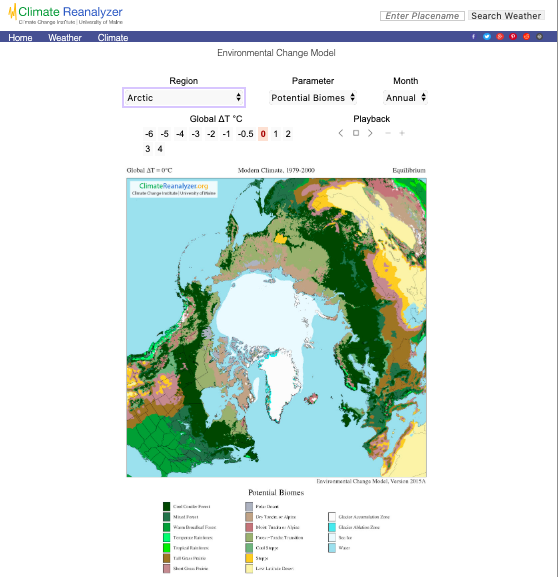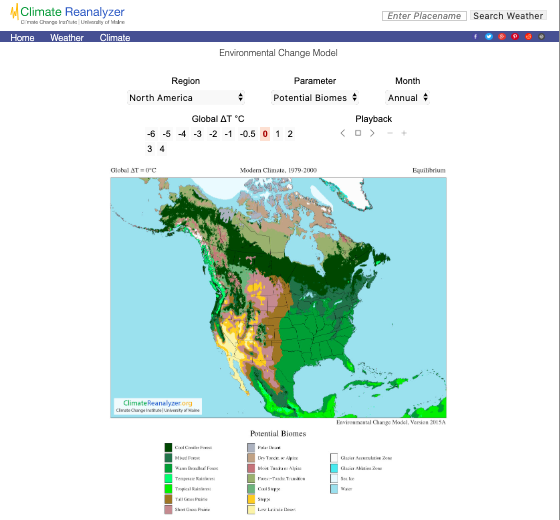20: Shifting Biomes
Key questions for this investigation
- How does rising global temperature impact the distribution of biomes on land?
- What factors are driving these changes?
- What are the implications of these changes on the plants and animals in the biomes?
Tool used for this investigation
- The Environmental Change Model <https://climatereanalyzer.org/clim/ecm/>in Climate Reanalyzer from the Climate Change Institute at the University of Maine <https://climatereanalyzer.org/>
Background
A Biome is a community of plants and animals inhabiting a region defined by climate and dominant vegetation. For instance, a tropical rain forest is defined as an area having rapid tree growth and high species diversity made possible by high year-round temperature and high annual rainfall. Biome Viewer, a tool used in an earlier activity, uses a largely biological scheme for classifying biome. The Environmental Change Model (ECM) in Climate Reanalyzer, on the other hand, uses a hybrid classification scheme for planetary biomes, so it defines the climatic characteristics of each biome more precisely than Biome Viewer does. ECM also breaks the earth’s biomes down into more categories than the viewer does. For instance, ECM defines a tropical rainforest as a region where the average monthly temperature is 21°C or above year-round.
A major concern about present changes in global climate is the extent to which changes in regional climate affect life in the planet’s biomes. The concern here is not only about the scale of regional climate changes, but also how quickly those changes take place. As the climate of a biome changes its inhabitants must either adapt to the new conditions or migrate to areas where the new conditions are like what they are accustomed to. In the case of the latter, the ability of plants and animals to survive the transition depends on whether or not regional climates are changing slowly enough that these organisms can successfully migrate and that there are no geographic obstacles to their doing so. This is an issue not only for wildlife and forest management, but also for agriculture and public health. There is strong evidence that many international conflicts and human migrations are a result of crop failures and climate related dislocations.
Investigation
Activity A – Biomes of North America
Launch the Environmental Change Model. See the first page of this activity for web address for the model. When you do this, you should see a screen that looks like Figure 1. Next select the region you in which you live, from the drop-down menu labeled “Region”. Then make sure that “Parameter” is set to Potential Biomes, “Month” is annual, and “Global ∆T°C” is set to 0. For instance, if you select North America you should see something that looks like Figure 2
 |
 |
|
Figure 1Default screen for the Environmental Change Model. The map here is showing biomes in the northern hemisphere from an arctic view. |
Figure 2The Environmental Change Model showing presents day biomes of North America. Information about the ECM and biomes is located further down on the page. |
Biome Characteristics – Questions
- What biomes are present in the region you selected?
With the ECM set up to show the region you live in, use the biome map and the information panels below the map to address the following questions.
- What are the primary characteristics of each biome?
- Approximately where are these biomes?
- Where do you currently live and in what biome is this place?
Activity B – Impact of rising global temperature on biomes
Begin this activity by switching the parameter to temperature.
Current temperatures – Questions
- What is the present range of the annual temperature on land in °C for your region? To find this make sure that Global ∆T°C is 0 and Month is set to annual.
- Where on land is average annual temperature below freezing (T < 0°C)? Where is annual temperature above 20°C?
With Parameter still set to temperature slowly shift Global ∆T °C from 0 to 4°C noting what happens to the temperature map as you do so.
Changes in temperature and precipitation – Questions
- At Global ∆T = +4°C where on land is average annual temperature below freezing. Where is annual temperature above 20°C?
- As you move from ∆T = 0°C to 4°C what happens to the areas where annual land temperatures are below freezing and those areas where it above 20°C?
- Now switch Parameter to precipitation and reset ∆T to 0°C. Make sure that Month is still set to annual.
- What is the present range the precipitation on land in cm for the region you selected?
- Where on land is it the driest and where is it the wettest? What is the value for precipitation at each place?
- At Global ∆T = +4°C where on land is it the driest? Where is it the wettest?
- As you move from Global ∆T = 0°C to +4°C what happens to these wet and dry areas?
Finally switch Parameter to Potential Biomes and reset Global ∆T to 0°C. Make sure that Month is still set to annual.
Biome Changes – Questions
- What biomes appear in those areas where the average annual temperature is below 0°C?
- What biomes appear in those areas where annual temperature is above 20°C?
- What biomes appear where the land is the driest?
- What biomes appear where it is the wettest?
- As you move from Global ∆T = 0°C to +4°C what happens to the biomes you listed in questions 9 through 12?
Activity C – Synthesis
Synthesis questions
- What general statement can you make about the impact of rising global temperature and the distribution of biomes?
- How does what you found out in questions 1 through 8 in activity B explain what you concluded in the previous question?
- What is the implication of what you concluded in questions 3 and 4 of activity B on the extent of permafrost in upper Canada and Alaska?

